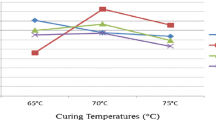Abstract
Steam-cured concrete is widely used to manufacture prefabricated units of high-speed railway foundation structure such as girder and track slab. The dynamic mechanical property of steam-cured concrete is one of the key properties affecting service performance of high-speed railway foundation structure. In the present paper, serial macro/micro-experiments were carried out to investigate the dynamic elastic modulus, shear modulus, damping ratio, and microstructure of steam-cured concrete. The relationships between compositions, curing regime, microstructure, and dynamic properties of steam-cured concrete as well as the corresponding mechanisms were discussed. The results indicate that steam-cured concrete in early age has a larger dynamic elastic modulus and shear modulus as well as a smaller damping ratio compared with standard-cured concrete. On the contrary, at a later age a slightly smaller dynamic elastic modulus and a larger damping ratio of steam-cured concrete are observed. Addition of mineral admixture results in a bit lower dynamic elastic modulus and damping ratio of concrete than that of the control specimen without mineral admixtures. The achievements can provide some fundamental suggestions for materials parameters selection during structural design of steam-cured concrete precast element.
Similar content being viewed by others
References
Escalante-Garcia J I, Sharp J H. The microstructure and mechanical properties of blended cements hydrated at various temperatures. Cement Concrete Res, 2001, 31: 695–702
Roy D M, Idorn G M. Hydration, structure, and properties of blast furnace slag cements, mortars and concrete. ACI Mater J, 1982, 79: 444–457
Brooks J J, Kaisi A F. Early strength development of Portland and slag cement concretes cured at elevated temperature. ACI Mater J, 1990, 87: 503–507
Kim J K, Han S H, Park S K. Effect of temperature and aging on the mechanical properties of concrete, part I: Experimental results. Cement Concrete Res, 2002, 32: 1087–1094
Cao Y J, Detwiler R J. Backscattered electron imaging of cement pastes cured at elevated temperatures. Cement Concrete Res, 1995, 25: 627–638
Barbarulo R, Peycelon H, Leclercq S. Chemical equilibria between C-S-H and ettringite, at 20 and 85°C. Cement Concrete Res, 2007, 37: 1176–1181
Lothenbach B, Winnefeld F, Alder C et al. Effect of temperature on the pore solution, microstructure and hydration products of Portland cement pastes. Cement Concrete Res, 2007, 37: 483–491
Erdogdu S, Kurbetci S. Optimum heat treatment cycle for cements of different type and composition. Cement Concrete Res, 1998, 28: 1595–1604
Ho D W S, Chirgwin G J, Mak S L. Water sorptivity of heat-cured concrete for bridge structures. In: Proceedings of 3rd CANMET/ACI International Conference on Advances in Concrete Technology. Auckland, New Zealand, 1997. 97–108
Ho D W S, Chua C W, Tam C T. Steam-cured concrete incorporating mineral admixtures. Cement Concrete Res, 2003, 33: 595–601
Liu B, Xie Y J, Li J. Influence of steam curing on the compressive strength of concrete containing supplementary cementing materials. Cement Concrete Res, 2005, 35: 994–998
Yazici H, Aydin S, Yigiter H, et al. Effect of steam curing on class C high-volume fly ash concrete mixtures. Cement Concrete Res, 2005, 35: 1122–1127
Long G C, He Z M, Omran A. Heat-damage of steam curing on the surface layer of concrete. Mag Concrete Res, 2012, 64: 1–10
Hu S S, Wand D R, Liu J F. Experimental study of dynamic mechanical behavious of concrete. Eng Mech, 2001,18:115–118
Liu H F, Liu H Y, Song W D. Fracture characteristics of concrete subjected to impact loading. Sci China Ser G, 2009, 39: 1231–1240.
Ning J G, Shang L. Sun Y X. The developments of dynamic constitutive Behaviors of concrete. Adv Mechanic, 2006, 36: 389–405
Yan D M, Lin G. Analysis of factors affecting the dynamic properties of concrete. World Earthquake Eng, 2010, 26: 30–36
Mehta P K, Monteiro P J M. Concrete: Microstructure, Properties and Materials. 3rd eds. New York: The McGraw-Hill Companies, Inc., 2006. 295–311
Author information
Authors and Affiliations
Corresponding author
Rights and permissions
About this article
Cite this article
Long, G., Wang, M., Xie, Y. et al. Experimental investigation on dynamic mechanical characteristics and microstructure of steam-cured concrete. Sci. China Technol. Sci. 57, 1902–1908 (2014). https://doi.org/10.1007/s11431-014-5635-9
Received:
Accepted:
Published:
Issue Date:
DOI: https://doi.org/10.1007/s11431-014-5635-9




